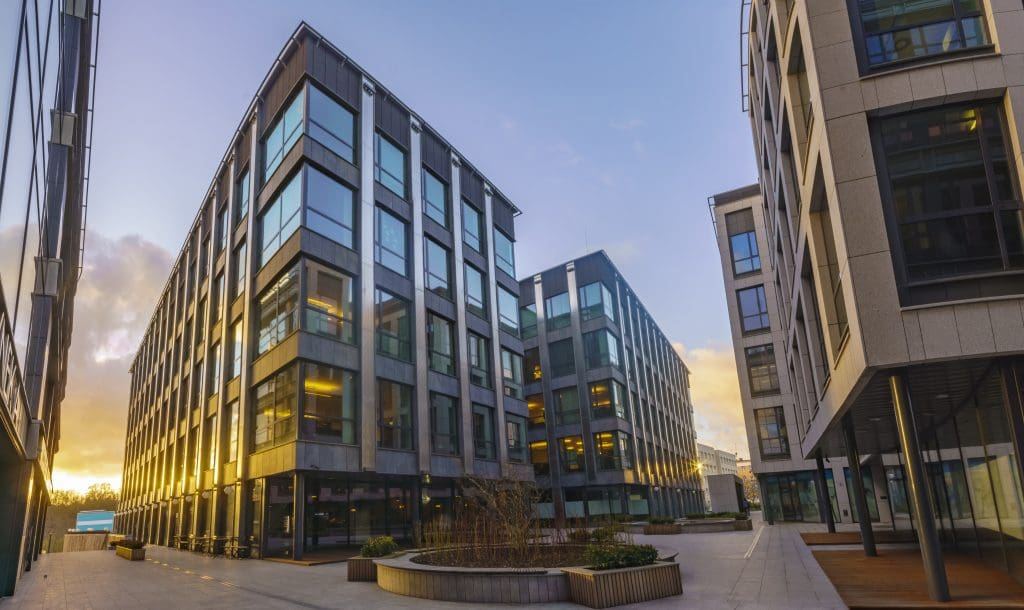This audio was created using Microsoft Azure Speech Services

Commercial real estate is a major contributor to carbon emissions, with studies showing that it may contribute as much as 40% of global greenhouse gases (GHGs). Since 80% of buildings that will be used in 2050 are already present, retrofits that improve sustainability in existing buildings are needed.
While upgrades can make buildings more sustainable, the commercial property segment needs help with profitability. With the lingering effects of the COVID-19 pandemic and the workplace behavior changes that followed, many commercial properties can’t realistically afford to invest in major upgrades across their portfolios.
Smart sensing enhances existing systems
Internet of things (IoT) sensing provides a practical first step towards sustainability by optimizing energy consumption and efficiency. Smart, wireless sensors simplify building upgrades, connecting seamlessly with existing integrated workplace management systems (IWMS) or building management systems (BMS).
Without wired solutions’ costly construction or interruptions, these cost-effective upgrades maximize energy efficiency via occupancy-tracking and indoor air quality (IAQ) sensors. They enable remote monitoring and management, automatically adjusting lighting, HVAC, and other functions in real time based on actual room usage, enabling predictive maintenance with minimal occupant disruption. Cloud-based smart sensors are easy to deploy and scale to manage thousands of devices feeding real-time data into the BMS or IWMS to:
- Maintain optimal environmental conditions
- Help ensure occupant comfort
- Maximize energy efficiency
IAQ sensors are crucial in enhancing energy efficiency by enabling demand-controlled ventilation. They adjust ventilation rates in real-time by monitoring pollutant levels, such as CO₂. This helps to minimize energy wastage by ventilating only when necessary.
When combined with occupancy sensors, IAQ sensors can optimize ventilation and air conditioning based on actual room usage, saving energy in unoccupied or low-occupancy areas. Moreover, energy management profiles are designed to extend the sensor’s battery life by adjusting reading frequency according to building usage schedules, such as differentiating between weekdays and weekends. Additionally, IoT-sensing solutions support green building certifications like LEED, enhance tenant appeal, and optimize asset value for owners.
What to look for in a smart sensing IoT solution
A smart sensing IoT solution can only support energy efficiency goals if it provides the right data type and detail to your BMS or IWMS. To ensure that you get maximum value from the investment, here are some things to look for.
- IAQ sensors. Wireless IAQ sensors should track a comprehensive set of environmental conditions, including temperature, humidity, CO2, volatile organic compounds (VOCs), pressure, noise, light, and (for more advanced sensors) particulate matter (PM). Readings should be available through an IWMS or other third-party platform.
- Desk occupancy sensors. Designed for stationary use on various furniture spaces, these devices should employ dual sensing technology to avoid false positives and include tamper detection, helping ensure uninterrupted data collection.
- Room occupancy sensors. Ceiling or wall-mounted, these sensors should provide 360° motion detection to ensure entire room monitoring coverage.
- IoT gateway. Should simultaneously communicate via multiple protocols, allowing for flexibility in sensor types. It should ideally use a mesh network capable of connecting 200+ devices.
- A cloud-based platform should include easy-to-use commissioning tools for configuring and supporting connected sensors and devices. It should also be scalable to thousands of devices to accommodate future upgrades and expansions. The platform should also provide open APIs to enable integration with preferred IWMS or BMS systems.
Moving towards sustainability
Upgrading existing commercial office buildings with IoT sensor solutions is a great step towards improving sustainability and occupancy well-being, improving space planning and operational efficiency, and meeting green building standards. To learn more, read other posts in our blog series and check out our EcoStruxure Building-IoT Sensor Solution.




Add a comment